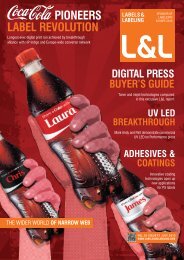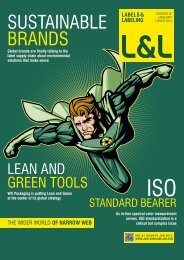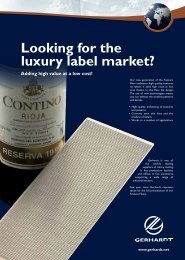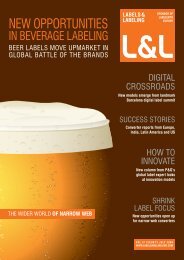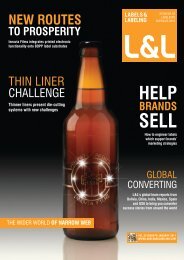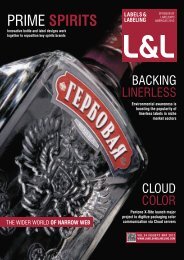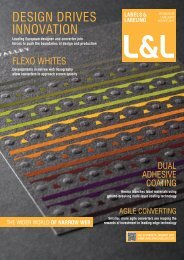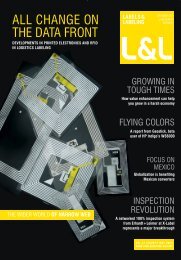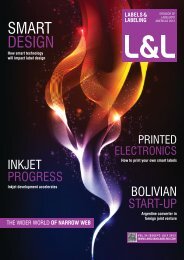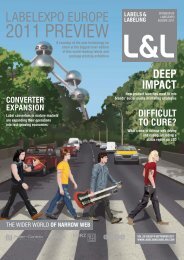LABELEXPO EUROPE BREAKS RECORDS
Download as PDF - Labels & Labeling
Download as PDF - Labels & Labeling
Create successful ePaper yourself
Turn your PDF publications into a flip-book with our unique Google optimized e-Paper software.
LABELS&LABELING |47<br />
The changing world<br />
of label printing<br />
FINAT has commissioned Mike Fairley to look at how label printing technology has evolved over the centuries<br />
and to consider some of the investment decisions facing converters today<br />
It’s now more than 400 years since the first recorded printed<br />
labels were being produced. At that time they would have been<br />
printed on hand-made paper using relief letterpress type or<br />
images cut into wood or metal, with impression pressure applied<br />
through a wooden hand press and simple screw mechanism.<br />
THE ‘PRE’ HISTORY OF LABELS<br />
It was a further 200 years before much began to change. Yes,<br />
the hand presses were now being made of iron with a lever<br />
system to apply pressure, but the paper was still made by hand.<br />
However, by the early 19th century the industrial revolution was<br />
bringing significant changes to the world of printing – the first<br />
cylinder printing presses (powered by steam), the offset printing<br />
process, continuous papermaking machines.<br />
The 1800s also brought coated paper, the halftone process,<br />
color printing – and a whole host of new label market application<br />
requirements that were to see the early beginnings of what we<br />
now call the label industry. These new 19th century applications<br />
included automatic volume production of standard-sized glass<br />
bottles and bottle filling lines, the first canning factories, the<br />
rapid growth of pharmacy products, labels on boxes, labels on<br />
luggage, labels on cigar boxes and bands, matchbox labels and<br />
all at this time now being printed on sheetfed offset or letterpress<br />
presses.<br />
The first part of the 20th century saw the introduction of the<br />
first narrow web presses for printing gummed and self-adhesive<br />
tape. The key innovations for the narrow web printer were<br />
developments by Stan Avery that enabled self-adhesive materials<br />
to have a backing carrier and be cut to shape on the press.<br />
It was die-cutting materials on a liner that now enables sticky<br />
labels to be produced on a roll. It was not long before press<br />
manufacturers such as Gallus, Nilpeter and Mark Andy were<br />
producing the early dedicated roll-label letterpress and flexo<br />
presses.<br />
At this time barcoded labels for labeling fresh produce in store<br />
and at pre-packers was being undertaken with heat-sensitive<br />
labelstocks. It was not until the 1980s that thermal direct and<br />
then thermal transfer printing of barcoded price-weigh labels<br />
using self-adhesive materials began to take place and grow<br />
rapidly by the later part of the decade.<br />
At about the same time the use of new types of polypropylene<br />
and polystyrene (later polyethylene) film materials for more<br />
demanding label applications were being introduced. High<br />
quality printing of filmic materials used for labeling shampoos,<br />
toiletries, industrial products, etc, were now required by the<br />
leading brand owners. This presented more demanding label<br />
printing and converting challenges for press manufacturers and<br />
converters.<br />
THREE DECADES OF EVOLUTIONARY CHANGES<br />
IN LABEL PRINTING TECHNOLOGY<br />
To meet changing label printing requirements over the past<br />
30 years the dominant label printing technology of the time<br />
has undergone several changes: In the 1980s it was rotary<br />
letterpress that dominated new press sales. Then came growth<br />
in the flexo process during the 1990s. Much of the early<br />
part of the 21st century has seen UV flexo as the dominant<br />
LATE 20TH CENTURY: EMERGENCE<br />
OF SELF-ADHESIVE IN <strong>EUROPE</strong><br />
Later came narrow web screen, hotfoil and combination process<br />
presses, UV-curing inks and more advanced platemaking<br />
technology. By the late 1970s self-adhesive labels had already<br />
attained a seven percent share of the European label market<br />
– with all printing processes being used. Today, self-adhesive<br />
labels make up around 40 percent of label usage, fuelled by a<br />
whole host of technology and press innovations over the last<br />
30 years that have enabled labels to be printed faster, on wider<br />
webs, using rotary and wrap-around tooling, servo-drive presses,<br />
and press controls that include web inspection, register control,<br />
color management, and much more.<br />
Unbelievably, it was not until 1978 that the first retail barcodes<br />
were being produced for the Fine Fare Supermarket’s own<br />
label products, and the very first time that a velocity code was<br />
incorporated on the film masters for the production of the dark<br />
vertical bars on the codes. Today, barcodes are an essential<br />
element of every label sold through retail outlets across Europe.<br />
NOVEMBER 2013 | L&L



